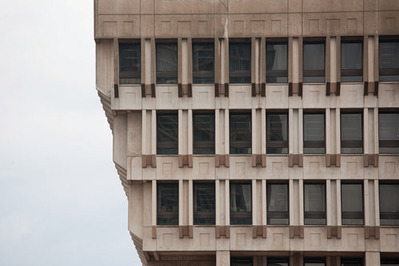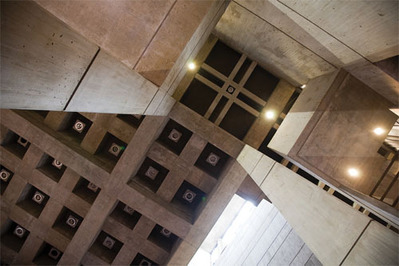Leave City Hall Alone!
As a dedicated rambler in Boston, I get no greater thrill than when I reach the top of the escalator at the Government Center T-Stop, step out onto the plaza, and see City Hall looming ahead of me, its ziggurat-like top stories cantilevering out like a flock of birds in v-formation. Monumental, a deconstructed Roman palazzo, it is a people’s palace, imposing, forbidding, accessible if not exactly welcoming. Instead of mounting a daunting set of stairs surmounted by a colonnade like a traditional city hall, one enters through a maw that opens under a projecting bay that contains the City Council Chambers and into a hall of breathtaking majesty. Inside, the lobby rises to the structure’s full height to capture the light like a great Gothic cathedral.
Americans pay good money to visit France in order to experience architecture of equal awesomeness. Yet no building in Boston is so reviled. The attacks, most of which are ill-informed, make my blood boil. Like the ditzy queen who tearfully defended Britney Spears in a 2007 video that went viral, I want to scream, minus the running mascara, “Leave City Hall Alone!”
The attacks come from all quarters. Mayor Menino, a self-proclaimed man of the people, famously hates it. He proposed to demolish it and build anew in the South Boston Innovation District he is so proud of. According to his office, he has backed off momentarily. In June 2012, the West Coast down-market shelter magazine, California Home + Design, listed it among buildings it would like to see demolished. In the August 12 Boston Sunday Globe, a know-nothing know-it-all named Joshua Rothman who was the editor of the column “Brainiac” cited City Hall as an example of intentionally ugly modern architecture.

Viera Levitt, Photography of Brutalist Architecture: Boston City Hall, 2012.
Courtesy of the artist.
Of course, City Hall has been praised since the day it was unveiled by architectural critics and historians who actually know something about architecture. And it has made many lists ranking the greatest buildings of the twentieth century. No matter. The hoi polloi can’t resist attacking what it can’t understand.
I can understand the lack of love. It is monumental, it is imposing, it is forbidding. That maw-like entrance is hard to find. City Hall does not pander; it does not ask to be loved; it risks being hated with the hauteur of a grande dame. It is totally sui generis. Take it on its own terms or don’t take it at all.
From its conception, City Hall has been a symbol of the New Boston. In a larger sense it is also a symbol of civic virtue and good government. It challenges the citizen to be as great—i.e., tough, independent, authentic, original—as it is. That, alas, is where it has most greatly failed. It asked too much of its public, and the citizens of the New Boston for the most part rejected it. Designed by the idealistic young firm of Kallmann, McKinnell & Knowles, it was built for a new world that didn’t come—in Boston or anywhere else either. There was no dawning of Aquarius, there was no advantage to wearing flowers in one’s hair. The revolution was not televised because it didn’t happen. The old gods failed and the new ones died aborning. In the meantime, we wait in a limbo of hopelessness. Boston City Hall may be the world’s greatest architectural monument to what might have been; that is, a world in which the citizen, not the banker, not the CEO, not the corporation, is king.

Viera Levitt, Photography of Brutalist Architecture: Boston City Hall, 2012.
Courtesy of the artist.
Although the building is unique, it does have precedents: the poured concrete (béton brut or raw concrete) aesthetic of French modernist Le Corbusier that inspired an international movement called, with unfortunate connotations in English, the New Brutalism. No place other than Great Britain embraced the sculptural possibilities of poured concrete more than Boston, and City Hall was its most celebrated (and damned) achievement. It also evokes building types of the distant past. Walter Muir Whitehill, the mid-century architectural historian of Boston’s past who welcomed its future, wrote that it suggested Mycenaean or Aztec precedents. Ancient and modern at the same time, it is timeless, but not placeless. One feels that it could only have been built in the city that cherishes low, heavy, masonry buildings, like the magnificent granite warehouses that thrust into the harbor along the waterfront, that seem to have risen from the earth—or the sea—of their own volition.
The selection of the Kallmann, McKinnell & Knowles design for City Hall occurred in 1962, fifty years ago. Preservationists often say that the first half-century marks the most vulnerable period in the life of a building, when it often requires expensive overhauls of its mechanical systems. That interval also marks the point of a building’s greatest unstylishness. Today, everyone loves rationalist glass and steel (Norman Foster and Renzo Piano) or computer-generated sculptural expressionism (Frank Gehry and Zaha Hadid). Few have use for dark, gloomy buildings of poured concrete that have become stained and pitted from wind and rain. Often they are easier to tear down than to restore, especially if they were never loved to begin with. That’s what happened after World War II with Victorian “monstrosities” that today would be lovingly rehabbed and recycled.
But often, just when a style has touched bottom, a new generation discovers its virtues. In the January 3, 2010, Boston Globe, architectural critic Robert Campbell cited the young Boston architectural firm over,under, which champions brutalist architecture, which it terms “heroic.” There were precious few heroes walking the earth in 1962 during the age of architectural heroism. There are fewer now. We have one political party that sees no virtue in the civic sphere and would like to see government dismantled. And another that has forgotten its modern roots in the New Deal and apologizes for government when it isn’t in the process of diminishing it itself. In the meantime, we wait—not for heroes but for citizens worthy of City Hall and everything it implies about free men and women in a free world.
______________________________________________________________________________________________________________
David Bonetti has been art critic at the Boston Phoenix, the San Francisco Examiner, the San Francisco Chronicle and the St. Louis Post-Dispatch. He returned to Boston two years ago to pursue a life of leisure befitting a retired gentleman, a goal he has failed to achieve.
